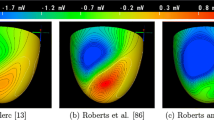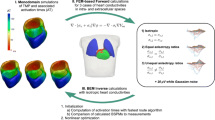Abstract
A method for determining the bidomain conductivity values is developed. The study was generated because the different sets of measured conductivity values reported in the literature each produce significantly different bidomain simulation results. The method involves mapping the propagation of the electrical activation of cardiac tissue, initiated by point stimulation, via extracellular electrodes. A time-dependent bidomain model is used to simulate the electrical phenomena. The optimum set of conductivity values is achieved by minimizing the difference between the bidomain model output and the measured extracellular potential, by means of inverse techniques in parameter estimation least-squares and singular value decomposition. The method is validated with synthetic data with added random noise. Other parameters in the model such as membrane capacitance and fiber angle can also be estimated. The method takes a different approach to the conventional four-electrode technique, as it does not require the small electrode separation needed to separate the extracellular current from the intracellular.









Similar content being viewed by others
References
Abramovici, F., and Y. Shoham. Inversion of anisotropic magnetotelluric data. Geophys. J. R. Astron. Soc. 50:55–74, 2009.
Beeler, G. W., and H. Reuter. Reconstruction of the action potential of myocardial fibres. J. Physiol. 268:177–210, 1977.
BioPSE: Problem Solving Environment for modeling, simulation, image processing, and visualization for biomedical computing applications. Scientific Computing and Imaging Institute (SCI). http://software.sci.utah.edu/biopse.html, 2002.
Clerc, L. Directional differences of impulse spread in trabecular muscle from mammalian heart. J. Physiol. 255:335–346, 1976.
Colli-Franzone, P., L. Guerri., and S. Rovida. Wavefront propagation in an activation model of the anisotropic cardiac tissue: asymptotic analysis and numerical simulations. J. Math. Biol. 28:121, 1990.
Colli-Franzone, P., L. Guerri, and B. Taccardi. Modeling ventricular excitation: Axial and orthotropic anisotropy effects on wavefronts and potentials. Math. Biosci. 188:191–205, 2004.
Cooley, R. L., and R. L. Naff. Regression Modeling of Ground-Water Flow: U.S. Geological Survey Techniques in Water-Resources Investigation. USGS Publications, 1990.
Doherty, J. PEST, Model-Independent Parameter Estimation. Watermark Numerical Computing, User Manual, 5th ed. 2006.
Entcheva, E., N. Trayanova, and F. Claydon. Patterns of and mechanisms for shock-induced polarization in the heart: a bidomain analysis. IEEE Trans. Biomed. Eng. 46(3):260–270, 1999.
Franzone, P. C., L. Guerri, M. Pennacchio, and B. Taccardi. Anisotropic mechanisms for multiphasic unipolar electrograms: simulation studies and experimental recordings. Ann. Biomed. Eng. 28:1326–1342, 2000.
Franzone, P. C., L. Guerri, and B. Taccardi. Potential distributions generated by point stimulation in a myocardial volume: simulation studies in a model of anisotropic ventricular muscle. J. Cardiovasc. Electrophysiol. 4(4):438–458, 1993.
Franzone, P. C., L. Guerri, and B. Taccardi. Spread of excitation in a myocardial volume: Simulation studies in a model of anisotropic ventricular muscle activated by point stimulation. J. Cardiovasc. Electrophysiol. 4:144–160, 1993.
Guyander, P. L., P. Savard, and R. Trelles. Measurement of myocardial conductivities with an eight-electrode technique in the frequency domain. In: Proceedings of 17th Annual International Conference of IEEE-EMBS, pp. 71–72, 1995.
Guyander, P. L., P. Savard, and R. Trelles. Measurement of myocardial conductivities with a four-electrode technique in the frequency domain. In: Proceedings of 19th Annual International Conference of IEEE-EMBS, pp. 2448–2449, 1997.
Henriquez, C. S. Simulating the electrical behavior of cardiac tissue using the bidomain model. Crit. Rev. Biomed. Eng. 21(1):1–77, 1993.
Henriquez, C. S., and A. A. Papazoglou. Using computer models to understand the roles of tissue structure and membrane dynamics in arrhythmogenesis. Proc. IEEE 84(3):334–354, 1996.
Henriquez, C. S., J. V. Tranquillo, D. Weinstein, E. Hsu, and C. R. Johnston. Three-dimensional Propagation in Mathematical Models: Integrative Model of the Mouse Heart. In: Cardiac Electrophysiology: From Cell to Bedside, 4 ed., chap. 30, edited by D. Zipes and J. Jalife. Saunders, 2004, pp. 273–281.
Hill, M. C. Methods and guidelines for effective model calibration. Technical report, U.S. Geological Survey Water-Resources Investigations Report 98-4005, 1990.
Hopenfeld, B., J. G. Stinstra, and R. S. Macleod. Mechanism for ST depression associated with contiguous subendocardial ischemia. J. Cardiovasc. Electrophysiol. 15(10):1200–1206, 2004.
Hunter, P. J., P. M. Nielsen, B. H. Smaill, I. J. L. Grice, and I. W. Hunter. An anatomical heart model with applications to myocardial activation and ventricular mechanics. Crit. Rev. Biomed. Eng. 20:403–426, 1992.
Johnston, P. R. Tissue conductivity and ST depression in a cylindrical left ventricle. Int. J. Bioelectromagn. 4(2):61–62, 2002.
Johnston, P. R., and D. Kilpatrick. The effect of conductivity values on ST segment shift in subendocardial ischaemia. IEEE Trans. Biomed. Eng. 50:150–158, 2003.
Johnston, P., D. Kilpatrick, and C. Y. Li. The importance of anisotropy in modeling ST segment shift in subendocardial ischaemia. IEEE Trans. Biomed. Eng. 48(12):1366–1376, 2001.
Keener, J. P., and K. Bogar. A numerical method for the solution of the bidomain equations in cardiac tissue. Chaos 8:234–241, 1998.
Krassowska, W., and J. C. Neu. Theoretical versus experimental estimates of the effective conductivities of cardiac muscle. Comput. Cardiol. 703–706, 1992.
Langrill, D. M., and B. J. Roth. The effect of plunge electrodes during electrical stimulation of cardiac tissue. IEEE Trans. Biomed. Eng. 48:1207–1211, 2001.
LeGrice, I. J., P. J. Hunter, and B. H. Smaill. Laminar structure of the heart. Am. J. Physiol. 272:H2466–H2467, 1997.
Levenberg, K. A method for the solution of certain non-linear problems in least squares. Q. Appl. Math. 2:164–168, 1944.
Li, C. Y. A Computer Simulation of ST Segment Shift in Myocardial Ischemia. PhD thesis, Division of Clinical Sciences, University of Tasmania, 1997.
Liu, G. R., and X. Han. Computational Inverse Techniques in Nondestructive Evaluation. CRC Press, 2003.
Luo, C., and Y. Rudy. A model of the ventricular cardiac action potential. Depolarization, repolarization, and their interaction. Circ. Res. 68:1501–1526, 1991.
Luo, C., and Y. Rudy. A dynamic model of the cardiac ventricular action potential. I. Simulations of ionic current and concentration changes. Circ. Res. 74:1071–1096, 1994.
Luo, C., and Y. Rudy. A dynamic model of the cardiac ventricular action potential. II. Afterpolarizations, triggered activity, and potentiation. Circ. Res. 74:1097–1113, 1994.
Macchi, E., M. Cavalideri, D. Stilli, E. Musso, S. Baruffi, G. Olivetti, P. R. Ershler, R. L. Lux, and B. Taccardi. High-density epicardial mapping during current injection and ventricular activation in rat hearts. Am. Physiol. Soc. 275:H1886–H1897, 1998.
Marquardt, D. W. An algorithm for least-squares estimation of nonlinear parameters. J. Soc. Ind. Appl. Math. 11:431–441, 1963.
Nielsen, P. M., I. J. L. Grice, B. H. Smaill, and P. Hunter. Mathematical model of geometry and fibrous structure of the heart. Am. J. Physiol. 260:H1365–H1378, 1991.
Plonsey, R. Quantitative formulations of electrophysiological sources of potential fields in volume conductors. IEEE Trans. Biomed. Eng. BME-31(12):868–872, 1984.
Pormann, J. A Modular Simulation System for the Bidomain Equations. PhD thesis, Duke University, Durham, NC, 1999.
Pormann, J. Cardiowave. http://cardiowave.duke.edu, 2005.
Roberts, D. E., L. T. Hersh, and A. M. Scher. Influence of cardiac fiber orientation on wavefront voltage, conduction velocity, and tissue resistivity in the dog. Circ. Res. 44(5):701–712, 1979.
Roberts, D. E., and A. M. Scher. Effect of tissue anisotropy on extracellular potential fields in canine myocardium in situ. Circ. Res. 50(3):342–351, 1982.
Roth, B. J. Action potential in a thick strand of cardiac muscle. Circ. Res. 68:162–173, 1991.
Roth, B. J. Electrical conductivity values used with the bidomain model of cardiac tissue. IEEE Trans. Biomed. Eng. 44(4):326–328, 1997.
Roth, B. J., P. John, and J. Wilkswo. The effect of externally applied electrical fields on myocardial tissue. Proc. IEEE 84(3):379–391, 1996.
Sadleir, R., and C. Henriquez. Estimation of cardiac bidomain parameters from extracellular measurement: two-dimensional study. Ann. Biomed. Eng. 34:1289–1303, 2006.
Schmitt, O. H. Biological information processing using the concept of interpenetrating domains. In: Information Processing in the Nervous System, edited by D. P. Zipes, J. Jalife, and K. N. Leibovic. Minneapolis, MN: Biophysical Science Group, 1969, pp. 325–331.
Sepulveda, N. G., B. J. Roth, and J. P. J. Wikswo. Current injection into a two-dimensional anisotropic bidomain. Biophys. J. 55(5):987–99, 1989.
Sobie, E. A., R. C. Susil, and L. Tung. A generalized activating function for predicting virtual electrodes in cardiac tissue. Biophys. J. 73:1410–1423, 1997.
Stinstra, J. G., B. Hopenfeld, and R. S. Macleod. Using models of the passive cardiac conductivity and full heart anisotropic bidomain to study the epicardial potentials in ischemia. In: Proceedings of the 26th Annual International Conference of the IEEE EMBS, pp. 3555–3558, 2004.
Stinstra, J. G., B. Hopenfeld, and R. S. Macleod. On the passive cardiac conductivity. Ann. Biomed. Eng. 33:1743–1751, 2005.
Sun, N. Inverse Problems in Groundwater Modeling. Kluwer Academic Publishers, 1999.
Taccardi, B., E. Macchi, R. L. Lux, P. R. Ershler, S. Spaggiari, S. Baruffi, and Y. Vyhmeister. Effect of myocardial fiber direction on epicardial potentials. Circulation 90(6):3076–3090, 1994.
Taccardi, B., S. Veronese, P. C. Franzone, and L. Guerri. Multiple components in the unipolar electrogram: A simulation study in a three-dimensional model of ventricular myocardium. J. Cardiovasc. Electrophysiol. 9:1062–1084, 1998.
Tonkin, M., and J. Doherty. A hybrid regularized inversion methodology for highly parameterized environmental models. Water Resour. Res. 41(W10):412, 2005.
Tung, L. A Bi-Domain Model for Describing Ischemic Myocardial DC Potentials. PhD thesis, Massachusetts Institute of Technology, 1978.
Vecchia, A. V., and R. L. Cooley. Simultaneous confidence and prediction intervals for nonlinear regression models with application to a groundwater flow model. Water Resour. Res. 23:1237–1250, 1987.
Vigmond, E. J., F. Aguel, and N. A. Trayanova. Computational techniques for solving the bidomain equations in three dimensions. IEEE Trans. Biomed. Eng. 49:1260–1269, 2002.
Zheng, X. Inversion for elastic parameters in weakly anisotropic media. Geophys. J. Int. 159:1077–1089, 2004.
Author information
Authors and Affiliations
Corresponding author
Additional information
Associate Editor Leonidas D. Iasemidis oversaw the review of this article.
Rights and permissions
About this article
Cite this article
Graham, L.S., Kilpatrick, D. Estimation of the Bidomain Conductivity Parameters of Cardiac Tissue From Extracellular Potential Distributions Initiated by Point Stimulation. Ann Biomed Eng 38, 3630–3648 (2010). https://doi.org/10.1007/s10439-010-0119-y
Received:
Accepted:
Published:
Issue Date:
DOI: https://doi.org/10.1007/s10439-010-0119-y




